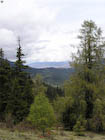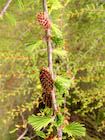Conservation Status

Larix potaninii
Batalin (1894)
Common names
红杉 hong shan [Chinese] (literally, red fir); Chinese larch. For var. himalaica, Langtang larch; 喜马拉雅红杉 Xu mi hong shan [Chinese].
Taxonomic notes
Four varieties:
- Larix potaninii var. potaninii. Type: not designated.
- Larix potaninii var. chinensis L.K.Fu & Nan Li (1997). Type: China, N Shanxi, "Kuon-tou-san" (mountain), J. Giraldi 6 (lectotype K).
- Larix potaninii var. himalaica (W.C.Cheng & L.K. Fu) Farjon & Silba (1990). Type: China, Xizang (Tibet), N side of Xomolungma (Mt. Everest), 3000-3500 m elevation, Climbing Team 80A (holotype PE).
- Larix potaninii var. macrocarpa Y.W.Law (1975). Type: China, Yunnan, 2800-3600 m elevation, Feng Guomei 9347 (holotype PE).
See POWO for synonymy.
Different authors have had varied views on the systematics of this species. Wu and Raven (1999) identified three varieties of L. potaninii: the type, L. potaninii var. australis, and L. potaninii var. chinensis. They also regarded L. himalaica as a distinct species, whereas Cheng and Fu (1978) had reduced it to synonymy. Eckenwalder (2009) accepted var. australis and placed chinensis into synonymy with the type, accepting these as geographically distinct taxa. Farjon (2010), on the other hand, working with the available herbarium material, went with a more complex taxonomy. He accepted the type and var. chinensis of Wu and Raven (1999), reduced their L. himalaica to a variety, disregarded their var. australis, and recognized var. macrocarpa Y.W. Law 1975 (which Wu and Raven had reduced to synonymy with var. australis). Finally, Debreczy and Rácz (2011) reduced var. australis and var. macrocarpa to synonymy with the type variety, while still recognizing var. chinensis as geographically isolated and both ecologically and morphologically distinct, and maintaining L. himalaica as a good species.
All varieties were assessed, with sample replicates from different portions of their distribution, in a detailed molecular study by Qiu et al. (2024). Results confirmed that the four varieties listed above are indeed discrete taxa, but L. potaninii var. himalaica was placed sister to L. griffithii var. griffithii, indicating that var. himalaica should be treated as a variety of L. griffithii, an idea that seems not to have occurred to the various authors who have treated himalaica at species rank, although it is biogeographically very plausible. A sister relationship was found between L. potaninii var. potaninii, L. potaninii var. macrocarpa, and L. mastersiana, with L. potaninii var. chinensis sister to this grouping.
Description
Trees up to 50 m tall and 100 cm dbh. Bark gray or gray-brown, smooth, becoming rough and longitudinally fissured on old trees. Crown conical, branches short, horizontal. Long shoots slender, drooping, red-brown or purple-brown, glabrous or very slightly hairy, turning grey after first year. Short shoots 3-8 mm diameter, densely covered with yellow-brown hairs at apex; winter buds brown or dark brown, resinous, glossy, ovoid. Leaves 12-35 mm long, 1-1.5 mm across, prominently keeled on both sides so as to seem 4-sided, apex pointed. Seed cones cylindric to ovoid, 2.5-7.5 × 1.5-3.5 cm at maturity, red or purple when young, maturing a deep purple, changing to light gray-brown; sessile. Seed scales 35-90, slightly convex, 0.8-1.6 × 0.8-1.1 cm, apex obtuse or sometimes notched; bracts often exserted, purple-brown, oblong-lanceolate, acute or acuminate. Seeds light brown with purple spots, obliquely obovoid, about 3 mm long with a 6 mm wing. Pollination occurs April to May, and seed maturity in October (Dallimore et al. 1967, Wu and Raven 1999). See García Esteban et al. (2004) for a detailed characterization of the wood anatomy.
The following criteria distinguish the varieties (based on keys and descriptions by Law [1975], Wu and Raven [1999], and Farjon [2010]):
- Var. potaninii: Seed scales dark brown or dark gray, wider than long. First-year long shoots in shades of brown; seed cones 3.5-8 cm long, 1.5-3.5 cm wide when cone is fully open.
- Var. chinensis: Seed scales dark brown or dark gray, wider than long. Short shoots 3-4 mm diameter, yellow, densely pubescent; first-year long shoots in shades of yellow; seed cones 2.5-5 cm long, 1.5-2.8 cm wide when fully open; seed scales striate on lower surface.
- Var. himalaica: Seed scales gray or yellow-gray, longer than wide. Seed cones to 6.5 cm long with mucronate cuspidate bracts. Young shoots yellowish orange.
- Var. macrocarpa: Seed cones 5-8 × 2.5-3.5 cm, with 50-80 seed scales; bracts 17-22 × 4-5 mm.
Distribution and Ecology
Nepal; E and S Tibet; and China: S Gansu, S Shaanxi, W Sichuan, and NW Yunnan, at elevations of 2,350 to 4,300 m, on acidic podzol soils; climate is cold, precipitation is 800 to 2,000 mm/yr. Associated trees are mainly conifers including species of Abies, Picea, Tsuga, Juniperus, Cephalotaxus and Taxus (Farjon 2010).
For the type variety, distribution and habitat is as above, except not reported in Nepal.
For var. chinensis, distribution is confined to Taibai Shan in S Shaanxi, at elevations of 2,600-3,500 m (Wu and Raven 1999).
For var. himalaica, distribution is confined to Nepal (Langtang Khola) and neighboring S Tibet (China: Xizang), at elevations of 2,800-3,700 m; it is reported only in the vicinity of Mt. Everest, in valleys on both the north and south sides (Wang and Zhong 1995, Wu and Raven 1999, Farjon 2010). Visiting populations in Nepal, Debreczy and Racz (2011) described it as occurring in riverside ravines and on rocky outcrops adjoining dense forests of Abies spectabilis, Tsuga dumosa, Alnus, Betula, Acer and Rhododendron; or in low scrub with Juniperus indica, J. recurva, and Rhododendron.
For var. macrocarpa, distribution is confined to Sichuan and Yunnan. Collections in Yunnan are reported at elevations 2700-4150 m in Deqin, Weixi, and Lijiang. In Sichuan, collections are reported at elevations 3200-4200 m in Muli, Yajiang, Xiangcheng, and Daocheng (Law 1975).
The type variety is hardy to Zone 5 (cold hardiness limit between -28.8°C and -23.3°C), while var. himalaica is hardy to Zone 7 (cold hardiness limit between -17.7°C and -12.2°C) (Bannister and Neuner 2001).
Distribution data from GBIF (2025). Var. chinensis in purple, himalaica in blue, macrocarpa in red, potaninii in yellow; gray icons indicate variety not specified, but most are in the range of var. potaninii. Click on an icon for more information.
"Wilson records it from the mountains of [Shaanxi] province westward to those of the Chino-Tibetan borderland. It is a common tree around [Kangding] at altitudes ranging from [2,290-3,350 m]. He further says, that it is a strikingly handsome tree and that it is the common larch of W. [Sichuan], where it occurs at elevations of [2,290-3,350 m] At its lower altitude it is scattered in moist woods, more especially by the sides of streams, with other conifers and broad-leaved trees, becoming more abundant as it ascends and forming forests at the higher alpine regions" (Dallimore et al. 1967).
Remarkable Specimens
The oldest reported living tree was 286 years old (crossdated) in 2018, growing on Taibaishan in Shaanxi at 3200 m elevation (Liu et al. 2019, citing Shi et al. 2018).
Ethnobotany
The timber is used for construction, railroad ties, and furniture, and the bark yields tannins. The species is also used for afforestation (Wu and Raven 1999).
Observations
Easily seen along the highway W of Kangding, Sichuan (Kham). Var. himalaica is reported from Qomolungma National Park in Tibet.
Remarks
The epithet honors Russian botanist Grigorii N. Potanin (Григорий Николаевич Потанин, 1835-1920), who collected in western China in the 1880's.
Citations
Batalin, A.T. 1894. Notae de plantis asiaticis XLIX-LXXI. Trudy Imp. S.-Petersburgsk. Bot. Sada 13:385.
Cheng, Wan-Chun, and Li-Kuo Fu. 1975. Gymnospermae Sinicae. Acta Phytotaxonomica Sinica 13(4):84. Available online at the Journal of Systematics and Evolution.
Debreczy, Z. and I. Rácz. 2011. Conifers Around the World. Vols. 1-2. Budapest: DendroPress Ltd.
Law, Y. W. 1975. Acta Phytotaxonomica Sinica 13(4):84. Available online at the Journal of Systematics and Evolution.
Liu, Jiajia, Bao Yang, and David B Lindenmayer. 2019. The oldest trees in China and where to find them. Frontiers in Ecology and the Environment 17(6): 319–22. https://doi.org/10.1002/fee.2046.
Qiu, Xiu-Fei, Yan-Yan Liu, Ge Wu, Cong-Hui Xu, Xin-Quan Liu, Xiao-Yan Xiang, Xiao-Xin Wei, and Xiao-Quan Wang. 2024. Phylogenomic analyses shed new light on the spatiotemporal evolution of global larches: implications for the dynamics of boreal forests. Molecular Phylogenetics and Evolution 202:108240. doi.org/10.1016/j.ympev.2024.108240.
Shi A., Li S., Hou L., et al. 2018. Research on the growth law of Larix chinensis in the Qinling Mountains on the basis of the tree-ring width. J Sichuan Forestry Sci Technol 39:1–6.
Wang Shimin and Zhong Shenxian in Schmidt and McDonald 1995.
See also
Elwes and Henry 1906-1913 at the Biodiversity Heritage Library. This series of volumes, privately printed, provides some of the most engaging descriptions of conifers ever published. Although they only treat species cultivated in the U.K. and Ireland, and the taxonomy is a bit dated, still these accounts are thorough, treating such topics as species description, range, varieties, exceptionally old or tall specimens, remarkable trees, and cultivation. Despite being over a century old, they are generally accurate, and are illustrated with some remarkable photographs and lithographs.
The species account at Threatened Conifers of the World.






